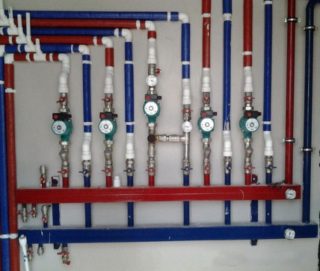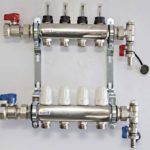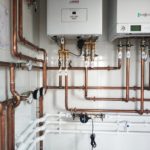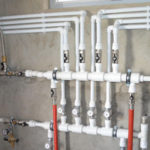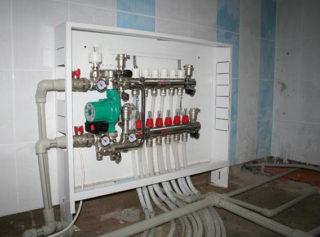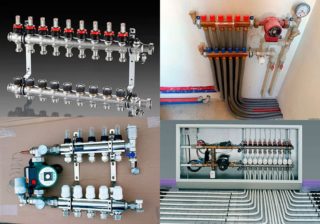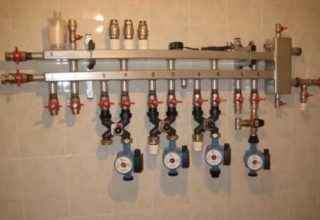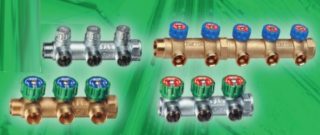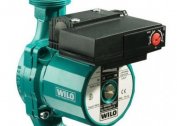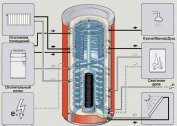The rejection of the standard single-pipe or two-pipe wiring in favor of a manifold distributor or comb makes it possible to save fuel and create comfortable conditions in all rooms. The comb for heating is an important component of the heating system, this part is divided into several types depending on the material, level of complexity and the number of places for connection. When choosing an element, you need to take into account the main criteria and study the installation rules in advance.
Classification of combs for heating
The comb for heating is selected depending on specific criteria. All devices of this type are divided into several groups. This includes selection according to the number of bends, the material of manufacture and the degree of difficulty, taking into account the installation in the heating home system.
By material
Polypropylene elements are considered inexpensive and economical. They have a high level of reliability and can be used with thermal media of any quality. Such options cannot be installed in systems operating under conditions of high pressure and high temperatures.
Elements made of steel are more durable, they are divided into two categories: versions made of stainless alloys and ferrous metal, which is coated with a layer of chromium or nickel. They have a long service life and are designed for long work. Non-ferrous metal parts are rust resistant, reliable and durable. Bronze or brass comb for underfloor heating or heating system is able to work at any pressure or temperature.
- Brass
- Copper
- Polypropylene
By level of difficulty
By type of circuit, design features and size of the part can be simple and complex. Simple elements distribute the flows of thermal media to the required number of nodes, due to which heat enters each room. They consist of a pipe part, connections on both sides, as well as branches from two to four in number. Their main disadvantage is the inability to control the flow of coolant streams.
The complicated distribution comb of the heating system has advanced functionality and many details. Their list includes pipeline fittings, an automatic system, sensors for monitoring or accounting for all variants of the heating system. In the details of this type, it is possible to independently supply and adjust the level, expenditure, supply and pressure of the thermal carrier.
Collector elements are also divided into categories according to the number of taps. They can be double, triple or quadruple, depending on the number of places to connect. Choose the appropriate option for this parameter, taking into account the design features of a particular heating system.
Comb Purpose
The collector or comb for plastic pipes and analogues of other materials is a tube with a plug in the end part and a pair of branches in the form of pipes that direct the heat carrier to individual points. The collector is designed to optimize the flow of heat carrier in the framework of the heating circuit and smoothing water hammer arising from the operation of boiler automation, which is responsible for temperature control.
The element is needed to create underfloor heating systems, and is also used in radiator-type heating systems.The collectors are connected according to the radiation scheme, each has its own supply and return pipes, with its help the heat carrier returns to the collector. Due to this heat distribution, the radiators are heated evenly, which makes it possible to regulate the temperature in all rooms or completely turn off the heating in a separate room.
Using a comb, you can connect additional devices, for example, a pool in a separate house that needs water heating. It can also be auxiliary energy sources, for example, solar panels.
Rules for placement and methods of installation of the collector
The comb for the heating system and underfloor heating should be stored in a manifold cabinet or a special niche, but such equipment is not required. Often on the equipment of this type install additional elements, including flow meters, valves, thermal heads and much more. They are designed to regulate the flows of the thermal carrier and their direction into a separate device.
The comb for standard or plastic pipes is complemented by taps that can be used to disconnect the collector. In addition to them, automatic type air vents are mounted on the collectors.
The collector must be connected to the riser and pull pipes from it to the plumbing elements. Two elements are placed in a standard heating manifold, designed to supply and return fuel. During installation, it is important to maintain the same distance between the collector and the heating device. Otherwise, on the longest sections of the system, the pressure will begin to exceed the norm. Each subsequent segment should be half the previous one.
In the closet
Under any floor or wall mounted collector, you can equip a separate cabinet or niche, which are located in the wall at a small height above the floor. Connecting the element is allowed only in a dry corridor or closet. Experts recommend the manufacture of sheet metal cabinets with technical openings and a door. In such drawers, additional fasteners for collectors are equipped, the cabinets themselves can be made with their own hands or contact the master.
On the wall
Collector elements placed in the pantry of the apartment can be hung on the wall using brackets. This saves time and money on the manufacture of the cabinet. Fasteners need to be selected taking into account the sizes of the comb.
Installation Rules
The comb is fixed to the wall with the help of brackets, then the main pipes are attached to the end and proceed to the strapping stage.
There are two ways to mount the comb: without a hydraulic arm or with equalizing the pressure. In the first case, a home-made or purchased collector will serve several circuit elements, where the temperature of the coolant will not be adjusted and will remain at the same level. Each circuit is connected directly to the element and one pump is connected to it for circulation. All equipment parameters must correspond to the performance of the heating system and the pressure of the heat carrier.
A pressure equalization method is needed when it is necessary to provide a different temperature at all points of consumption. For example, in batteries it should be kept within 50-80 degrees, in systems for underfloor heating from 40 to 50 degrees.
A water gun is a piece of pipe that is sealed on both sides and supplemented by several nozzles. The first pair is needed to connect the hydraulic gun to the boiler equipment, the second is required to connect the combs. This is a convenient barrier creating a zone for low hydraulic resistance and fluid collection.
Criterias of choice
The element model must be selected at the design stage. The number of pins for the collector should match the number of loops. Due to the length of the routes and the pressure inside the network, pumps are not used for the purpose of forced fluid flow. In private buildings, where more than 100 meters are laid, for pipes you need to create additional traction inside the system. When installing underfloor heating, pressure differences often also occur.
The right comb should balance performance. During the selection, they primarily look at the pressure indicators, as well as the temperature. Such an element can be of a simple or complex type, the second option is suitable for those who need a comb with auxiliary options. Innovative elements help to set and control the temperature, as well as other indicators.
Options with temperature sensors help determine in which rooms the heat transfer is faster, where water gives less energy. Due to proper adjustment, the fluid will not get to where it is not required.
When choosing, always take into account the material from which the comb is made. It can be cast iron, steel, brass or plastic. The ideal option would be cast elements that exclude any leaks.
